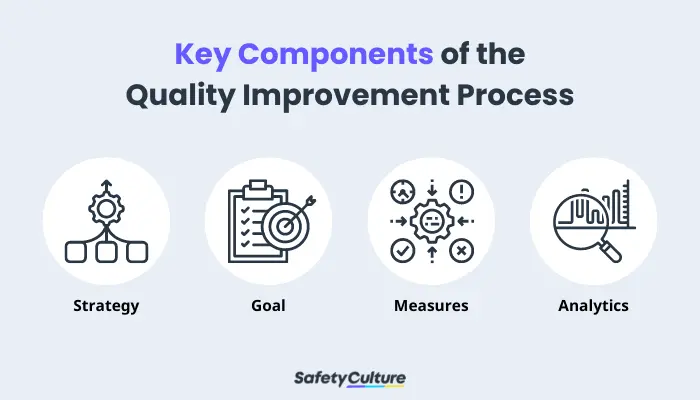What is Quality Improvement Process?
Quality improvement process refers to the way of systematically making an organization’s collective behavior and activities aligned toward ensuring that the same inputs (e.g., how products are manufactured or how medical services are delivered) are providing the same desired results through standardization and reduced process variation. This is commonly applied in construction, service, and manufacturing industries but can also be utilized in other sectors such as health and education.
Key Components

Key Components of the Quality Improvement Process
What are the 4 key components of the quality improvement process?
The process of quality improvement can have a higher chance of being successful in an organization if it’s based on the following:
1. Strategy
Having something that needs to be resolved is at the heart of the quality improvement process. This component is where teams and organizations aim to deeply understand and assess the issue for ideating, building, and choosing the most appropriate initiative, effort, or strategy to be implemented. This is crucial to ensure that organizations’ time and resources are best allocated.
2. Goal
To make the initiatives more aligned with the process of identifying the strategy, a goal or a set of goals must be set to guide everyone involved in the quality improvement process on what needs to be achieved. In this component, there are guide questions that can be asked to help clearly define the right goals. These are some examples:
- How can the entire quality improvement process affect the overall organizational objectives?
- What are the risks associated with implementing improvement efforts?
- How can we measure the effectiveness of the improvement initiatives we implemented?
This component also reinforces the need to set SMART goals to establish a clear foundation for the overall quality improvement process.
3. Measures
It’s also important to remember that implementing programs and initiatives in the quality improvement process can lead to different outcomes. Two of these are generating results and seeing improvements in the overall quality of the system in an organization. The latter is more impactful in this case, and having standard measures in place to assess the effectiveness of initiatives is a must.
4. Analytics
Measuring the results and improvements generated from the efforts you applied in the quality improvement process should also entail the way they are analyzed. This is to extract clear insights and help assess if the desired results were achieved, how effective the current improvements are being done so far, and what actions should be continued.
What are the Steps in the Quality Improvement Process?
With all the critical components of an efficiently conducted quality improvement process, the approach to how they are put into action is crucial in determining their purpose for the quality improvement process steps involved.
In Lean methodology, the Plan-Do-Check-Act (PDCA) cycle or thought process must be followed. The steps involved are:
- Problem Statement or Strategic Alignment
- Current Condition
- Desired Future State
- Gap Analysis and Goal Setting, which involves conducting root cause analysis, creating an action plan, measuring progress, and adjusting strategies.
On the other hand, Six Sigma follows the Define, Measure, Analyze, Improve, and Control (DMAIC) methodology.
Hence, the general sense of the quality improvement process can be broken down into these specific steps:
- Identify opportunities.
- Define objectives and requirements.
- Gather and sort data.
- Determine the root cause.
- Ideate and implement possible solutions.
- Continuously monitor.
Create Your Own Quality Improvement Audit Checklist
Eliminate manual tasks and streamline your operations.
Get started for FREETips for Facilitating the Process
Implement these tips to make the continuous quality improvement process more efficient and streamlined:
- Start with small, incremental improvements. These are easier to manage in the long run.
- Encourage and empower involvement. Establish ways for each member of the organization to make their mark in the overall efforts involved in the quality improvement process.
- Implement the process as a mindset. Creating corrective and preventive actions along with other solutions are all part of continuous improvement.
FAQs About Quality Improvement Process
These are four interrelated elements that organizations must consider in their Quality Management System (QMS). In most cases, these form a holistic cycle of quality planning, quality control, quality assurance, and quality improvement. Each of these serves a different purpose, but all contribute to the big picture.
Senior leaders serve as the organization’s core decision-makers. They are typically tasked with setting organizational goals and objectives and coordinating with managers and project owners to ensure that the quality improvement process is continuously being implemented.
Definitely, as it seeks to enhance, streamline, and standardize processes on how an organization’s products and services are continuously improved toward customer satisfaction. Also, processes that have reduced variation and a higher potential of delivering the same desired results help the organization be more efficient and competitive when it comes to service quality and cost-effectiveness.
While each organization may face different scenarios and problems in their quality improvement efforts, some of the most common challenges they may encounter include the following:
- Choosing and implementing the most appropriate systems and processes efficiently
- Getting buy-in from the leadership and/or management teams
- Not being able to align proposed solutions to the overall organizational objectives



